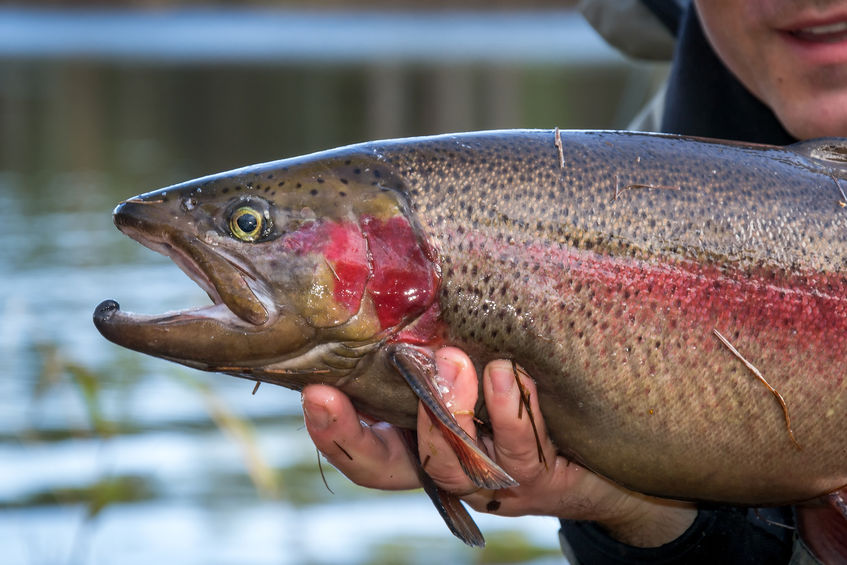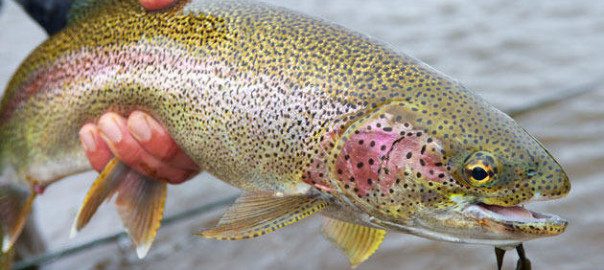Oncorhynchus mykis – aka Steelhead – are a unique form of rainbow trout. Born in high country freshwater, they experience a physiological transformation within a year that allows them to survive in the ocean. They spend most of their lives there, but instinct brings them back to spawn in freshwater streams and rivers. Only one or two out of a hundred survive the ocean’s dangers to return to their place of origin, some small patch of gravel in a vast world.
Steelhead have been known to grow to 55 pounds and reach 45 inches in length, although most are much smaller. Found along the entire Pacific Coast, they are now considered endangered due to a steep decline in numbers, the natural environmental conditions and, of course, man’s “delicate” touch.
Steelhead Endangered
The Endangered Species Act protects Oncorhynchus mykis, and that’s a good thing considering the current state of the fish population. All over California scientists and fishermen alike talk about the giant schism between what was and what is now. Urban sprawl, agricultural water diversion and pollution have all taken a toll. Man’s desires have forced streams into culverts and drainage pipes and concrete channels.
In Southern California, Malibu Creek looks like a promising piece of water. It was once a great little steelhead river that would entice Spencer Tracy and Clark Gable (among others) to halt production of movies so they could chase the fish when they would come in from the Pacific. But those days are long gone, slowly ended first by the building of the Rindge Dam (limiting the steelhead run to the last two miles of the creek) and since by urbanization and pollution.
Similar stories can be told about dams on other Southern California rivers – the Santa Ynez, Mission Creek, the Ventura, the Santa Clara, the Los Angeles, the Santa Ana, Santa Margarita, San Mateo and the San Luis Rey. These and other dams defeat the steelhead’s spawning efforts. Even though steelhead can adapt to some variance in conditions the population in SoCal has decreased by over 99% since the 1950s. That’s correct: 99%.
In Central California a small population of steelhead are attempting a recovery in the Stanislaus River, which flows into the San Joaquin Valley. Since the Endangered Species Act protects steelhead, a federal fisheries agency told the California branch of the Bureau of Reclamation that the fish needed enough to get out to ocean. The Bureau initially complied, but subsequently refused – saying the water was better used for “human interests” – in other words, for agriculture.
This is only the beginning. Water skirmishes are taking place all over the West, and achieving a reasoned balance of water distribution is a political hot potato.
Chasing Chrome in Northern California
But there is some hope for those mad few committed to catching (and hopefully releasing) steelhead. If you want to “chase chrome” (fish for steelhead) in California the best place to go is about 275 miles north of San Francisco to the waters of California’s Six Rivers National Forest. The six rivers here include the Smith, Klamath, Trinity, Mad, Eel, and Van Duzen.
In this area it is said that the best time to fish is from January through March; to be even more specific, when the rivers are dropping and clearing. Steelhead are called the Fish of a Thousand Casts for good reason: the effort is great and the catch count low. You’ll find yourself fishing in rain and snow storms, with water freezing in rod guides. You might fish for days without a strike. Then again, you might hit that magic day where you’ll land more than a few. Remember: it’s called fishing, not catching.
 Renowned fishing writer Paul Quinnett and whimsical artist Deanna Camp team up to show you the fish you’ll forever want to catch, because you’ll almost certainly never catch one. Still, hope springs eternal in the breast of every angler, which is really the whole point.
Renowned fishing writer Paul Quinnett and whimsical artist Deanna Camp team up to show you the fish you’ll forever want to catch, because you’ll almost certainly never catch one. Still, hope springs eternal in the breast of every angler, which is really the whole point.
This is the perfect gift for a fly fisher who loves a good cocktail with their wild fish stories! To aid the in joy of the journey, mix yourself one of this book’s tasty libations, build your campfire, sit back for some highly entertaining fish stories and lose yourself in the search. The 120-page book features both full-color paintings and photographs. Buy Now




